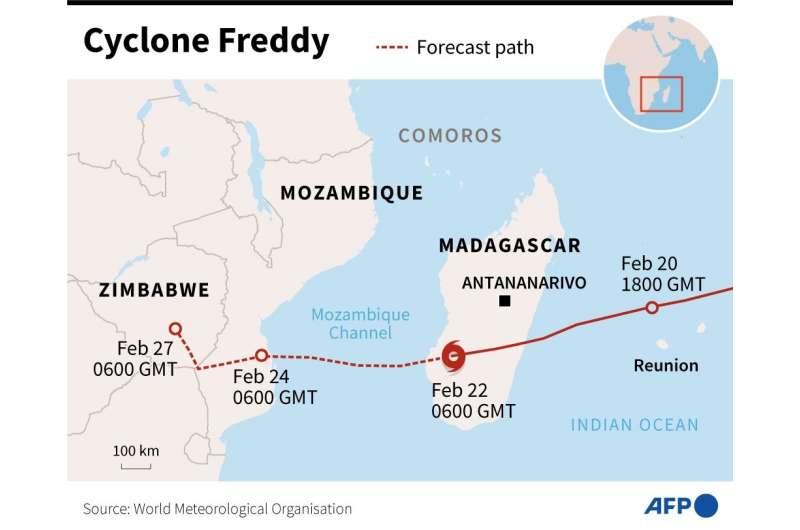Cyclone Freddy.
A powerful cyclone was barrelling towards Mozambique on Wednesday after battering Madagascar where it killed five people but left less devastation in its wake than feared, emergency officials said.
Authorities gave a provisional toll of five dead after Cyclone Freddy made landfall on the Indian Ocean island late Tuesday, packing winds of around 130 kilometers (80 miles) per hour.
More than 16,700 people were affected and around 4,500 homes flooded or damaged, the National Risk Management Office (BNGRC) said in an update.
France's weather service Meteo-France said Freddy weakened as it tracked across Madagascar, dropping to an average wind speed of 55 kph.
But, the agency warned, the storm would pick up strength from the warm Mozambique Channel as it headed towards the African mainland.
Cyclone Freddy is expected to land Friday in regions between central and southern Mozambique, more than 500 kilometers north of the capital Maputo, and could reach Zimbabwe.
Mozambique's government has declared a red alert to allow agencies to prepare for a potential emergency.
Freddy had developed into one of the biggest cyclones in recent years to threaten Madagascar, which is typically lashed several times during the annual November-April storm season.
In the end, it brought less rain than feared but still ripped roofs off buildings and flattened rice fields and fruit trees.
It made landfall north of Mananjary, a coastal town of 25,000 people that remains devastated by last year's Cyclone Batsirai, which killed more than 130 people.
"It's a dry cyclone compared to Batsirai, so it brought fewer rains, but the winds were stronger, this is why infrastructure was badly affected," risk management senior official Faly Aritiana Fabien told AFP.
"The recorded damage is almost only related to the wind."
'Can't take this'
As Freddy closed in after brushing Mauritius and the French island of La Reunion without causing major damage, the authorities put in place an array of measures, including school closures and the precautionary evacuation of people in high-risk areas.
Despite thousands of sandbags used to reinforce roofs, metal sheets and electric cables were blown off by the force of the wind.
Pascal Salle sobbed as he assessed the damage after hardly recovering from last year's Cyclone Batsirai.
"I didn't think there was a more powerful cyclone than Batsirai," he said, listing his losses which included a broken fence and a water tank that was smashed against a wall.
"I can't take this every year, it's not possible," he said.
But Red Cross spokeswoman Mialy Caren Ramanantoanina said the damage was not as bad as with Batsirai.
"No immediate large-scale disaster," said Joaquin Noterdaeme of the French aid group Doctors of the World (Medecins du Monde).
Mozambique next
Freddy is the first cyclone and the second tropical weather system to hit during Madagascar's current season, the UN's Office for the Coordination of Humanitarian Affairs said.
The storm began to brew in the first week of February off the northwest of Australia and south of Indonesia and is now in its third week trekking across the Indian Ocean.
At its height, Freddy was a "supercyclone", with average wind speeds of 220 kph and gusts of 320 kph, said Meteo-France's cyclone specialist for the Indian Ocean, Sebastien Langlade.
The UN's World Food Programme had estimated more than 2.3 million people in Madagascar could be affected.
The cyclone coincides with a months-long drought in the southern part of the island that has inflicted widespread hunger.
Freddy is expected to make landfall in Mozambique on Friday as a likely tropical storm, bringing the risk of pounding rain and flooding, according to forecasts.
Mozambique is already in the middle of its rain season and the soil is saturated.
Authorities reported that dozens of houses in the central port city of Beira had flooded Wednesday.
Heavy rain could also hit parts of Zimbabwe and South Africa at the weekend.
© 2023 AFP
























